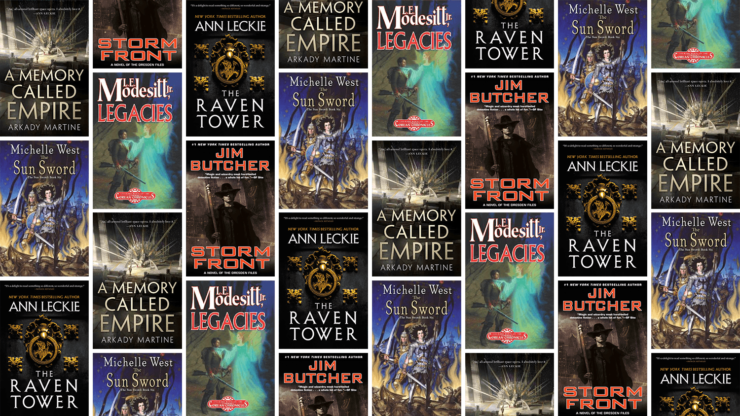There’s a whole sub-genre of books that can be described as “History… IN SPACE!”—for example, Valor’s Choice by Tanya Huff and David Weber’s Honor Harrington series—and are a wonderful means of introducing readers to different historical periods in a thoroughly engaging way. Most of what I know about the Zulu and Napoleonic Wars I encountered first in one of those books. In the realm of fantasy, Rebecca Roanhorse’s Black Sun exposed readers to cultural aspects of Mesoamerican societies that they had potentially not previously encountered. And of course there exists an entire website devoted to exploring the well-known connections between Game of Thrones and the War of the Roses, along with other historical inspirations for the Song of Ice and Fire series.
In many cases, those relationships between historical events and people and the fiction they inspire are relatively obvious—right there on the label, as it were. But of course, there are more subtle influences and echoes of history that reverberate through SFF, parallels that might be harder to pick up on, but which can still inform and challenge the way we think about the world…
The Raven Tower by Ann Leckie (2019)
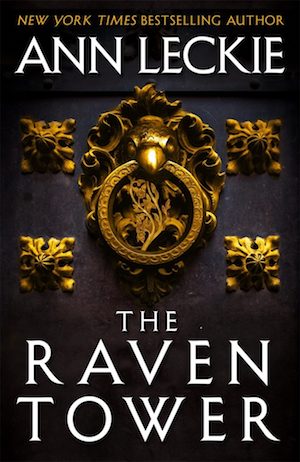
The Strength and Patience of the Hill, who narrates The Raven Tower, is a big rock—who also happens to be a god. According to Adrienne Mayor’s The Amazons, the Scythians of the Eurasian Plains happened to worship a very particular large black stone:
Veneration for a sacred black stone was a prominent feature of ancient Anatolian worship of the great “mountain mother” Cybele of Asia Minor. […] At Cybele’s sanctuary at Pessinus in central Anatolia, the goddess was worshipped in the form of “a black stone that fell from the sky.” (from Chapter 10, the “Amazon Religion” section.)
This sort of veneration of a meteorite is relatively unusual from a historical perspective. Ann Leckie does a fantastic job of showcasing how this sort of religious belief might come to be, without at any point being dismissive toward the beliefs and practices of different cultures. The Strength and Patience of the Hill is one of many gods who play a role in The Raven Tower, which relies on the trope of gods gaining strength through faith and worship.
During the “flashback” scenes of The Raven Tower, Strength and Patience of the Hill makes an effort to stay out of the affairs of the world. It is, in fact, moderately appalled to discover that people have been worshipping and praying to it, because in many cases, Strength and Patience of the Hill deliberately ignored the prayers of the faithful, deliberately failing to respond to attempts to use rune-stones for communication. But sheer chance and coincidence were enough to convince people that Strength and Patience of the Hill was listening, and helping.
Looking back into real-world history, one can imagine the ancient Phrygians having a similar sort of relationship with Cybele.
***
The Sun Sword Series by Michelle Sagara West (1995-2019)
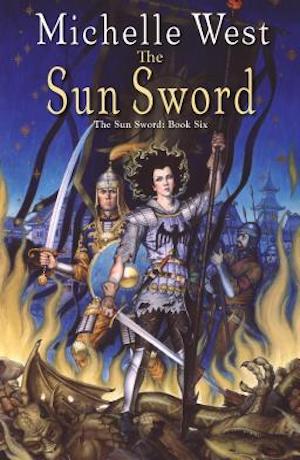
Serra Diora di’Marano is a woman born to harem life, who finds peace with the harem, and is able to use the power of her beauty, her musical talents, and her familial connections to seize power and become, in essence, a kingmaker. Although the series features many powerful women, it does not shy away from depicting the ways different cultures perceive and enforce gender roles.
The Essalieyan Series as a whole is incredibly complex—The Sun Sword was apparently pitched as a duology and became six books nestled in the middle of a ten book series. What really stood out, though, was the power Diora was able to seize despite never stepping outside of an incredibly circumscribed role. The series never flinches away from showing how different cultures limit and control women—but at the same time, it does a great job of showcasing how women can still manage to achieve power and agency, even in a conservative culture that effectively banishes women from public life.
When the average reader imagines a Syrian princess from the Bronze Age, “powerful diplomat” is probably not the image that springs to mind. “Kingmaker” is a term applied to women only rarely, and usually only in cases where male heirs were thin on the ground. But in the Fertile Crescent, both terms applied to princesses. According to Brotherhood of Kings by historian Amanda Podany, Syrian princesses served in a vital diplomatic role. It wasn’t just because their marriages and motherhood bound their fathers and husbands together in common cause, either. Princesses wrote frequent letters home, facilitating and easing the relationships between kings by giving critical advice based in their unique insight and access—they were often considered to be one of the only people a king could trust to give honest, accurate advice. And for much of Egypt’s history, who the Pharaoh’s eldest daughter married had a much greater impact on who would rule than who his eldest son may have been. (Note: As pointed out in the comments, this research has since been discredited.)
***
The Corean Chronicles by L. E. Modesitt, Jr. (2002-2011)
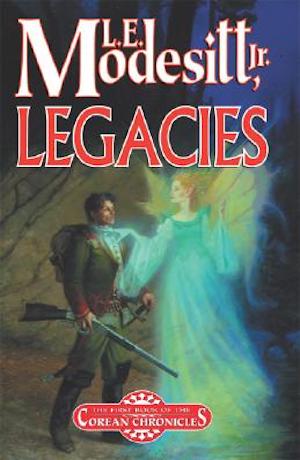
While L.E. Modesitt, Jr. generally eschews “shameless copies of history” in fiction, he demonstrates a thorough and historically grounded understanding of how societies function throughout his own work. So while the Duarchy at the heart of The Corean Chroniclesis not a particularly close mirror of Roman society, there is still a lot to be gleaned about Rome from it. The series begins at the end, historically speaking, with the protagonist of Legacies living millennia after the fall of the Duarchy featured in Alector’s Choice. The time of the Duarches featured significantly more impressive technology than the world that remains centuries later. Alucius’ experiences as a young man growing up surrounded by technology that would be impossible to replicate can help the reader empathize with how Medieval herders living in the shadow of the fallen Roman Empire might have felt, looking at aqueducts they didn’t know how to repair and roads whose quality they couldn’t hope to replicate.
It’s a particularly close parallel given that at times the Roman Empire, much like early Corus, was ruled by two leaders who collaboratively presided over different geographic spheres. Though Rome didn’t start out with a pair of rulers, co-consuls were common during the Republic, and the Emperor Diocletian’s reforms split the Empire into Eastern and Western halves that ultimately resulted in the rise of Byzantium.
***
A Memory Called Empire by Arkady Martine (2019)

Arkady Martine has been upfront about drawing inspiration from historical sources, writing about borrowing from Byzantine and Mesoamerican history for her first novel, A Memory Called Empire. One of the neatest little touches in the book, though, is in the formulation of Teixcalaanli character names, which are made with numbers paired with nouns, where both parts have symbolic meaning. Although names like “Three Seagrass” may sound a little strange to the Western ear, they do illuminate the startling variety of naming conventions that have existed throughout history.
The effect is a subtle sort of reminder that different cultures consider and interact with names differently. A name like Rufus Scipio (which literally means Red Staff), might remain Latinized in a book inspired by Roman history, but in a culture where names carry symbolic or specific types of cultural significance, not simply assigned as a convenient way to differentiate between individuals, the meaning itself is what is important.
***
The Dresden Files by Jim Butcher (2004—Present)
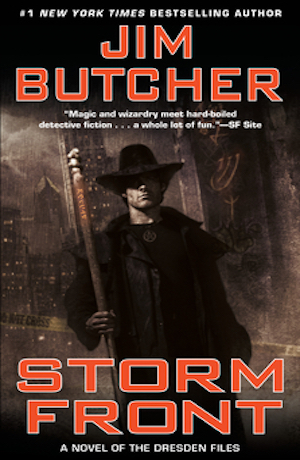
Although tropes about Faerie, including the idea of the Summer and Winter courts, binding oaths, and an aversion to iron come out of the Celtic tradition, many of these ideas predate even the oldest of the gods that appear in The Dresden Files series. The long history of hospitality rites and guest/host relations, for example, goes back farther than most people think—predating even Homer’s Iliad, in which two rivals immediately stop their fight when they realize that their grandfathers had a guest-host relationship.
Back around the time that the horse was first domesticated, formalized guest/host relationships were vital to mobile herders. These relationships offered a way to distinguish between people who would travel through a particular pasture within one’s territory and follow the norms and rules necessary to keep their lifestyle functional—and those who couldn’t be trusted and should therefore be driven out.
The Dresden Files make this ancient philosophy more accessible and relatable to a modern reader. If we imagine the Nevernever as a landscape not dissimilar to the ancient Eurasian plains, we can start to put the pieces together of how considerations of trust and territory—which matter so much to the beings of the Nevernever that they literally cannot violate their oaths—might have looked to our ancestors.
***
One of the great wonders of speculative fiction—and fiction in general—is how it gives us an opportunity to empathize with people in situations and contexts far removed from our own. After all, narratives help us learn. Please share in the comments any experiences you’ve had where a SFF story helped you discover an obscure piece of history, or helped illuminate past cultures, people, and events.
Eleanor Konik studied philosophy and religion before graduating law school in 2011. These days, she teaches Ancient Civilizations and spends the bits of time left over writing stories that bring history—and magic—to life. You can find more articles about worldbuilding, ancient civilizations, and mythology at her website.










